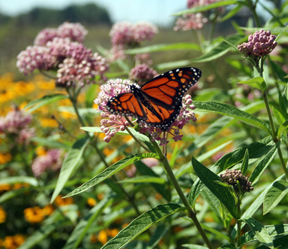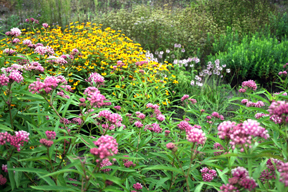Why do we need rain gardens?
As development increases, the ability of our environment to perform its natural processes decreases. This is because the natural landscape that was once able to absorb and clean stormwater is covered by impervious surfaces. Impervious surfaces are simply surfaces that water is unable to penetrate. Rooftops, driveways and roads are all examples of impervious surfaces. Increased impervious surfaces result in an increased amount of stormwater runoff and an increased chance for pollution to enter our waterways through our storm sewer systems. This type of pollution that results from stormwater runoff is called nonpoint source pollution. Studies have shown that up to 70 percent of the pollution in our streams, rivers and lakes is carried there by runoff from practices we carry out in our own yards and gardens.
Some of the common “nonpoint source pollutants” from our yards that end up in our local waterways include soil, fertilizers, pesticides, pet wastes, grass clippings and other yard debris. Rain gardens capture the rain that would usually runoff your property and allow it to soak into the ground. This helps minimize runoff and helps reduce the amount of pollution that enters our waterways.
Rain gardens perform the following functions: filter stormwater runoff before it enters local waterways, alleviates problems associated with flooding and drainage, recharges the ground water supply, provides habitat and food for wildlife, including birds and butterflies, and enhances the beauty of yards and the community.
The best types of plants to use in a rain garden are Michigan natives. Why? Native plants have adapted to living in our soils and weather conditions. They are easy to care for since they need little if any fertilizer or pesticides, and once established, infrequent watering. Native plants have deep roots systems that channel water deep into the soil and provide soil stability preventing erosion.
For more information about rain gardens including where to locate and how to calculate the ideal size for your site, visit the following websites:www.raingardens.org and www.geaugaswcd.com/rain_gardens.



 Print
Print Email
Email




